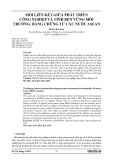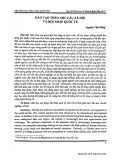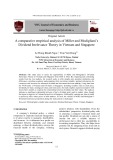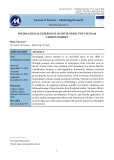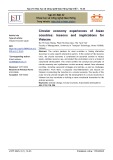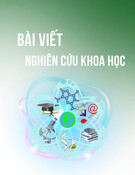
* Corresponding author
E-mail address: rid_one1905@yahoo.com (M. Ridwan)
© 2019 by the authors; licensee Growing Science.
doi: 10.5267/j.uscm.2019.6.001
Uncertain Supply Chain Management 7 (2019) 589–598
Contents lists available at GrowingScience
Uncertain Supply Chain Management
homepage: www.GrowingScience.com/uscm
Zakat collection and distribution system and its impact on the economy of Indonesia
Muhtadi Ridwana*, Nur Asnawia and Sutiknoa
aMaulana Malik Ibrahim State Islamic University, Indonesia
C H R O N I C L E A B S T R A C T
Article history:
Received May 6, 2019
Received in revised format May
19, 2019
Accepted June 1 2019
Available online
June 1 2019
The purpose of this study is to examine the relationship between zakat collection and
distribution as core supply chain perspective for their economic impact in the region of
Indonesia. The study collects the necessary data from various respondents who are paying
zakat and interacting with various collections and distribution centers of zakat. A sample of
362 respondents is finally observed for descriptive, correlational and regression analysis. It is
observed that both collection and distribution of zakat are core indicators in terms of supply
chain with their economic outcomes. More specifically, zakat collection and distribution have
positive impacts on equal distribution of wealth, cleanliness of wealth, economic growth,
provision of educational facilities to needy students, and delivery of good health facilities in
Indonesia. In addition, it is also found that more collection and distribution centers can lead to
better economic output in the economy, where the role of mosques and Muslim community
center is very important. Besides, some limitations in the current research need to be
readdressed in future. First, the study has provided a limited context of zakat collection and
distribution which could be expanded while adding the latest policies being adopted by the
local government and their economic impact. Second, future studies could be reconsidered
through getting the significant responses from those who are directly linked to the collection
and distribution of zakat as they have much more body of knowledge about their economic
implications.
., Canada
b
y the authors; licensee Growing Science2019 ©
Keywords:
Zakat collection and distribution
Economic growth
Supply chain
Indonesia
1. Introduction
For the economic development and growth in Islamic economy, zakat is playing its own significant
role (Yusoff, 2011). The reason is that funds collected from zakat help the community who are
financially under pressure (Ali & Hatta, 2014). In this regard, payment of zakat is an obligation for
those Muslims who have excessive wealth up to a specific limit as prescribed by Shariah laws (Kuran,
1986; Lewis, 2001). Several benefits have been observed through zakat system in the community like
minimizing the gap between rich and poor, provision of various facilities like health, education,
transportation and other necessities of those who are not under good financial conditions (Sarea, 2012;
Suprayitno et al., 2017; Yusoff, 2011). For the management of zakat, various systems have been
adopted in the world’s economy. For instance, from the context of Malaysia, it is the obligation of each
state to collect the zakat funds (Rahim & Rahman, 2007). In this regard, the role of Indonesian agency

590
is significant which is responsible for collecting and distributing zakat payments to the needy people
in the local community (Bakar & Abdghani, 2011; Havidz & Setiawan, 2015; Ali et al., 2016;
Hammoud & Bittar, 2016; Bittar, 2017; Javaid & Alalawi, 2018; Hassan & Alanazi, 2018).
Considering the economy of Indonesia, as per the findings of Sudibyo (2017) to reduce the poverty in
the country, contribution of zakat payments is very much significant. As the country of Indonesia is the
biggest in terms of Muslim community with almost 85 percent of the local individuals belong to the
religion of Islam, huge funds are collected in the form of zakat from such community. Fig. 1 below
provides an outlook for the total billion Rupiah, million US dollars, annual growth in percentage and
GDP growth in percentage in the economy of Indonesia. It is found that from 2002 to 2015, there wa
an increase of 5310 percent and over the period 2005-2007, the increase in zakat collection and payment
was more than 100 percent (Sudibyo, 2017). The reason is that during these years, country was faced
with the biggest disaster in the form of Tsunami which had targeted the major areas. However, from
2002 to 2015, an average increasing of 39.28 percent was observed. In addition, collection of zakat,
Infaq and Sadaqah has also shown to be higher than the GDP growth rate during the year of 2009.
Meanwhile due to global financial crisis, GDP growth rate was declined from 1.3 percent, whereas
growth rate of zakat has been increased to 6.11 percent (Sudibyo, 2017).
Fig. 1. Time Series Graphs of Zakat, infaq and sadaqah in Indonesia
Source: (Sudibyo, 2017)
The present study considers the factor of zakat collection and zakat distribution as two key dimensions
of supply chain perspective in Islamic finance to examine their economic impacts in Indonesia. To the
best of author’s findings, this study is the first attempted for examining the interaction between zakat
collection and distribution with economic outcomes. The rest of the study is as follows. Section two is
devoted to the literature review, which is mostly from the context of ASEAN region like Malaysia and
Indonesia. Section three covers methods, variables and sample of the study. Section four provides
empirical and descriptive findings and their discussion. Last section covers the conclusion and future
recommendations of the study.
2. Literature Review
There are various studies explored the idea of zakat collection and distribution in different economies
of the world. For instance, Zainal et al. (2016) explain that zakat is among the five basic pillars of Islam
and considers it as basic obligation for the Muslims. They explain that zakat plays its major role to
alleviate the poverty and to minimize the gap between rich and poor. In this regard, authors discus three
key factors of reputations, satisfaction and quality of services to affect the stakeholders’ trust in zakat
institutions in the region of Malaysia. While research work conducted by Kaslam (2009) empirically

M. Ridwan et al. /Uncertain Supply Chain Management 7 (2019)
591
investigates the governance of zakat as social institute in Malaysia as well. Author has claimed the fact
the zakat management system must be integrated with the courtesy, plan of integrity, loyalty and as
social institutions for the better growth and economic output. In addition, Ahmad and Ma'in (2014)
examine the efficiency of zakat collection and distribution through two stage analysis, for this purpose,
data envelopment analysis model is utilized for the collection and distribution of zakat along with
technical efficiency of the model. Meanwhile, overall efficiency and cost benefit analysis reveals the
fact that there is a presence of cost minimization with the proper output from the resources through
better utilization. Some other studies also provide their theoretical and empirical contributions in the
field of Islamic finance for zakat distribution and collection (Ab Rahman et al., 2012; Bakar &
Abdghani, 2011; Muda et al., 2009; Nadzri et al., 2012; Wahab et al., 2012; Wahid & Kader, 2010).
However, from the context of Indonesia, research studies have focused on the strategic model to
increase the efficiency of zakat through zakat management system and poverty control (Manara et al.,
2018), mobilization of zakat payments (Doktoralina et al., 2018), zakat management system in
contemporary Indonesian economy (Adachi, 2018), Shariah governance compliance for zakat
management (Hakim et al., 2019), fund raising to optimize zakat collections (Bidin et al., 2009; Grais
& Pellegrini, 2006; Idris et al., 2012; Kasri & Putri, 2018) and efficiency of zakat collection institutions
in Indonesia (Lessy, 2009; Siswantoro & Dewi, 2007; Siswantoro & Nurhayati, 2012) . Besides,
research work conducted by Doktoralina et al. (2018) has observed the accounting zakat and its role in
the field of supply chain management in Islamic economy. Authors have claimed that zakat can play
its significant role as support function in supply chain literature. Findings of their study reveal that there
is a significant need to reconsider the various Islamic concepts to get more benefits from Islamic
finance.
3. Methods and variables of the study
For better understanding, this study has adopted the primary data collection measure in the form of
questionnaire to get the significant responses from the targeted respondents in the region of Indonesia.
In the very first step, questionnaire is developed while taking zakat collection and distribution as major
explanatory variables. For zakat collection system and its efficiency measurement, seven items are
added to the questionnaire covering the title of ZCF1 to ZCF7. For zakat distribution six items under
the title of ZDF1 to ZDF6 are considered for which the details are given under the results and discussion
portion. For economic output, ten items are added, covering the title of increasing economic prosperity,
increasing social wellbeing, cleanliness of wealth, right people to get the portion of zakat in the
economy, social growth and economic wellbeing, increasing growth rate in the economy through better
living for poor/needy, equal distribution of wealth, helping needy students for better educational
facility, helping needy students for better educational facility, and Provision of good health facilities
through zakat bases health centers, ranging from EIMP1 to EIMP10. A sample of 362 respondents is
finally observed for descriptive, correlation and regression analysis of the study. Descriptive analysis
provides the overview about the dataset, correlation indicates the association between the variables,
while regression analysis explains the causal association between dependent and independent variables
of the study.
4. Results and Discussion
Table 1 shows descriptive facts, mean score, status of the mean score on Likert scale, standard
deviation, minimum and maximum score with the sample respondents. It is observed that most of the
indicators have shown their average score above four, reflecting the point of strongly agree on five
points Likert scale. For common understanding, those items having mean score of above 4.50 are scaled
as strongly agree and those below 4.50 but equal to 4 are scaled as “agree” on the Likert scale.
Maximum mean value is observed for ZCF5 which measures the fact that efficient serving the zakat
collection system in local region of Indonesia. The 2nd highest mean score is associated with ZCF3
which shows good satisfaction level when payment is made to zakat collection center in the local area

592
of Indonesia. For zakat distribution ZD, the highest mean score is observed for ZDF2 which specifies
that efficient distribution of zakat is found in local community of Indonesia. For the factors of economic
impact of zakat collection and distribution, the highest mean score is observed for EIMP6 which is
4.561 and for EIMP5, respectively. All the items under Table 1 also present the values of the standard
deviation which are above 1 but less than 2.
Table 1
Descriptive Statistics
Variable Obs Mean Status on Likert Scale Std.Dev. Min Max
ZCF1 362 4.793 Strongly agree 1.126 1 5
ZCF2 362 4.569 Strongly agree 1.069 1 5
ZCF3 362 4.815 Strongly agree 1.12 1 5
ZCF4 362 4.033 Agree 1.278 1 5
ZCF5 362 4.981 Strongly agree 1.206 1 5
ZCF6 362 4.674 Strongly agree 1.169 1 5
ZCF7 362 3.818 Agree 1.129 1 5
ZDF1 362 4.787 Strongly agree 1.127 1 5
ZDF2 362 4.82 Strongly agree 1.26 1 5
ZDF3 362 4.564 Strongly agree 1.077 1 5
ZDF4 362 4.558 Strongly agree 1.054 1 5
ZDF5 362 4.34 Agree 1.009 1 5
ZDF6 362 4.699 Strongly agree 1.141 1 5
EIMP1 362 4.149 Agree 1.089 1 5
EIMP2 362 4.492 Agree 1.137 1 5
EIMP3 362 4.597 Strongly agree 1.041 1 5
EIMP4 362 3.434 Strongly agree .986 1 5
EIMP5 362 4.461 Agree 1.021 1 5
EIMP6 362 4.561 Strongly agree 1.025 1 5
EIMP7 362 4.094 Agree 1.103 1 5
EIMP8 362 3.92 Near to agree 1.054 1 5
EIMP9 362 4.525 Strongly agree 1.107 1 5
EIMP10 362 4.359 agree 1.169 1 5
Table 2 shows the correlation matrix between the variables items of independent variables; zakat
collection and distribution system in the region of Indonesia. It is observed that correlation between
ZCF1 and ZCF2 is .434 indicating a moderate level of association. While correlation between ZCF3
and ZCF1 is 56.7 indicating an above average association. The rest of the other indicators present low
and moderate level of relationship with each other. To identify either the correlation between these
items is problematic or not, variance inflation factor test is applied which represents individual VIF,
1/VIF and mean score of VIF for all the items, having good correlation. It is observed that ZCF5 and
ZCF3 have a VIF score of 2.161 and 2.125. While for other items this tolerance score is below 2. By
the end of Table 3, mean VIF score of 1.765 shows that there is no problem for higher correlation
between the stated items, hence considered for the regression analysis to study the impact of zakat
collection and distribution on the economy of Indonesia.
Table 2
Correlation Matrix
VARIABLES (1) (2) (3) (4) (5) (6) (7) (8) (9) (10) (11) (12) (13)
(1) ZCF1 1.000
(2) ZCF2 0.434 1.000
(3) ZCF3 0.567 0.428 1.000
(4) ZCF4 0.011 0.252 0.078 1.000
(5) ZCF5 0.493 0.397 0.549 0.014 1.000
(6) ZCF6 0.386 0.342 0.462 0.068 0.481 1.000
(7) ZCF7 0.419 0.359 0.460 0.102 0.596 0.450 1.000
(8) ZDF1 0.415 0.420 0.491 0.124 0.458 0.494 0.401 1.000
(9) ZDF2 0.399 0.481 0.347 0.086 0.461 0.357 0.454 0.398 1.000
(10) ZDF3 0.343 0.377 0.445 0.224 0.347 0.232 0.310 0.332 0.322 1.000
(11) ZDF4 0.420 0.496 0.491 0.165 0.333 0.370 0.237 0.475 0.320 0.391 1.000
(12) ZDF5 0.370 0.542 0.353 0.195 0.395 0.240 0.373 0.300 0.436 0.494 0.400 1.000
(13) ZDF6 0.374 0.454 0.438 0.094 0.473 0.269 0.351 0.348 0.463 0.375 0.426 0.537 1.000

M. Ridwan et al. /Uncertain Supply Chain Management 7 (2019)
593
Table 3
Variance inflation factor
VIF 1/VIF
VIF 1/VIF
ZCF5 2.161 .463
ZCF1 1.746 .573
ZCF3 2.125 .471
ZDF1 1.723 .58
ZDF5 1.921 .521
ZDF2 1.672 .598
ZCF2 1.914 .523
ZCF6 1.62 .617
ZCF7 1.83 .546
ZDF3 1.559 .641
ZDF6 1.766 .566
ZCF4 1.153 .867
ZDF4 1.755 .57
MEAN VIF
1.765 .
Table 4 presents the regression findings for the economic impact of zakat collection and distribution in
the region of Indonesia. It is observed that the factor of the presence of zakat collection center has its
positive influence on the value of social well-being in Indonesia. This effect implies that with the
presence of more collection center of zakat in Indonesia, more social wellbeing will be experienced,
accordingly. The rest of the indicators from the economy are found to be insignificantly associated with
the presence of zakat collection center. The 2nd indicator for zakat collection is measured through its
smooth working. It is found that smooth working of zakat collection system has its own significant and
positive influence on economic prosperity in Indonesia. The coefficient of .220 is significant at 1
percent, which means that there is a significant and positive association between the working of zakat
collection system and economic performance in Indonesia. ZCF3 or proper network of zakat collection
indicates its positive impact of right distribution of zakat to needy people and social growth with
economic wellbeing as well. This effect is significant at 5 and 1 percent level of significance. Through
efficient serving of zakat collection center, it is observed that right distribution of zakat is possible, and
this claim is accepted at 5 percent significance level with the coefficient of .0805 and standard error of
0.0380, respectively. Social awareness in the local community indicates its positive impact of .176 on
cleanliness of the wealth for local individuals. With the good satisfaction level of payment for the zakat
at local collection center, respondents believe that it will take to the cleanliness of their wealth with the
coefficient of .146 and for social growth, its effect is .162, respectively. After the collection center, the
effect of distribution system on the economy is observed. It is extracted that with the quality distribution
of zakat in the local area of Indonesia, right distribution of zakat and social growth with economic
wellbeing will be observed. One of the most significant contribution in zakat distribution system is
found through mosques and local community center. It is found that both mosque and Muslim
community centers are positively affecting the zakat distribution which in return leads towards
increasing economic prosperity, increasing social wellbeing, cleanliness of the wealth, right distribution
of zakat and social growth and economic wellbeing is found. It means that the first five indicators for
economic impact of zakat distribution are significantly and positive affected by the role of mosques
and Islamic centers in Indonesia. While the factor of overall management system of zakat in the local
economy has its own positive influence on the right distribution and the social growth factors.
Additionally, findings through regression analysis under Table 4 indicates that more distribution system
can lead to positive influence on increasing social wellbeing, cleanliness of wealth and social growth
with economic welling.
Table 4 presents the effect of zakat collection and distribution as the 2nd five measures of economy. It
is observed that the presence of proper zakat collection center has its own positive and significant
influence on the provision of good health facilities to the needy individuals in Indonesia. Besides, ZCF1
has presented its own direct influence on the growth rate in the economy through provision of better
standards of living. This effect is significantly positive at 1 percent level of significance. ZCF2 impact
on provision of good health facilities is also significantly positive with the coefficient of .146 and
standard error of .0725. Meanwhile, the idea of proper network of zakat collection has its direct
influence on equal distribution of wealth and helping the needy students for better education in the
society. It means that when the network of zakat collection is improved, it will directly affect the
education system in a positive way and equal distribution of wealth in the society as well.



